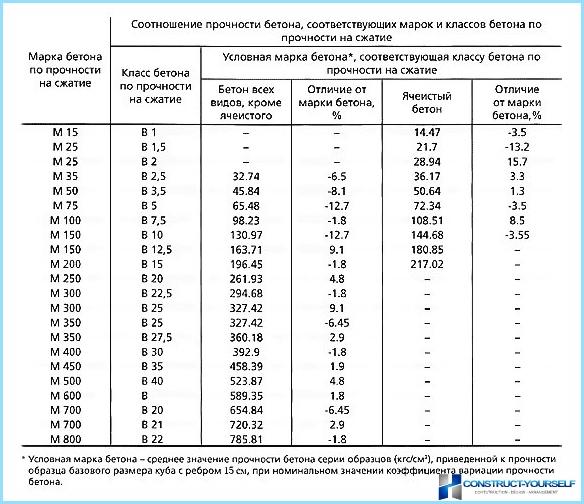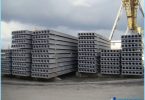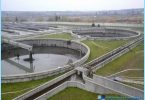The contents
The concrete is very well mixed and compacted mass that is produced from a special material (cement) with the addition of water in very precise proportions, which subsequently hardens to stone status.
Set out the types of concrete mixes in this article are the most useful at the moment. After reading that, you will be able to learn a lot of new.

In our twenty-first century, a variety of concrete just off the charts. It is used in the construction of various objects. For example, to create the Foundation of buildings, ceilings for basements, protection already applied concrete mixtures from various external factors, for design of stairs, creating load-bearing structures, walls and so on.
An important factor is the process of preparation and application of concrete. But in this article we will talk not about that, and what are the different types of concrete and what it is connected.
Concrete is often used in the construction of various facilities. The construction works are performed by very few specialists in their field, especially if the owner decided to build a house yourself without being a professional in the construction industry. Often is not acquainted beforehand with all «palette», when you choose ready mix concrete, he thereby puts his future building to premature failure, deformation and low strength under all possible external influences on the object. It is important to remember that the correct choice of concrete mix is fifty percent of success in the construction of the building. Making it a solid basis, you can be sure in reliability for years to come!

Till the moment of hardening, the texture of sand, water, gravel and cement is concrete mixture. The main performance advantages of concrete is its superior resistance to stress, compression and stretching.
But this is not enough to use only one concrete to build structures which will be designed for high loads. To increase its strength using rebar that perfectly absorbs all kinds of tensile forces that can act on the concrete structure. The combination of reinforcement and concrete is called reinforced concrete.
It happens that even this is insufficient when the result of very high loads, cracks can form. For such situations, the builders have developed a way «pre-stressing of concrete». Its essence is that the poured concrete mass, which stretch, compress tight fittings. As a result, tensile force acting on the structure, will perceive the rebar and not concrete.
Classification of concrete ↑
Concrete klassificeret average density per cubic meter and are divided into:
- superheavy – more than 2450 kg/mThree. Heavy concrete produced from such materials as magnetite and hematite. The ore rock are crushed to the status of sawdust, shavings and scale. Such material is used only in the construction of nuclear power plants, to protect areas from radiation;
- heavy – from 1700 to 2400 kg/mThree. Heavy concrete is the most popular form of a mixture, it has high popularity in the construction and underground structures, as well as in the construction of simple walls, partitions and foundations. As the main component of the mixture is the crushed rocks such as limestone, diabasic, granite, etc.;
- easy – from 250 to 1700 kg/mThree. To the group of lightweight concrete are mixtures, composed of porous fillers (both artificial and natural), sometimes even without filler, with the use of artificial closed pores within the concrete mix. Typically, lightweight concrete is used as a durable thermal insulation structure in private homes;
- ultralight – up to 450 kg/mThree. Ultra-light concrete mix, as a rule, act as heat-insulating cellular concrete, with a large number of pores created on the basis of light porous aggregates. This kind of concrete structures are distinguished by high thermal insulation and can be used not only for thermal insulation of walls, floors or ceilings, but also as a holistic design from the external temperature factors.

Variety of concrete regarding its structure ↑
On the market the concrete mix can meet with the following structures:
- compacted. Densified is a structure in which try to achieve maximum space filling in the concrete, i.e. not to leave free zones, which could reduce the density and hardness of the material. This kind of concrete made from coarse and fine aggregates and dense binders.
- porous. The porous structure is filled with a bonding substance into a porous state. Used in the construction of walls and facades.
- wire mesh. Cellular structure is considered to be the concrete mixture, which shall not include any fillers. Instead, it is filled with a large number of artificial rocks in the form of closed cells filled with air. This structure is widely used in the construction of single-storey houses.
- corporate. The structure of this kind serves only one coarse aggregate, without the use of sand rocks.
Videos on the topic of what are the different types of concrete:
Variety of concrete relative to the binding agent ↑
If we consider classes of concrete on its inner fillers, we can highlight the following:
- on the basis of cement. Cement concrete is a mixture of clinker, of Portland, shlakoportlandtsement and pozzolanic cements. It is the most spread type of concrete. It is used in the construction of multistory buildings;
- the silicate mixture. The concrete made from such mixtures obtained on the basis of binders of limestone. In the production of this type used autoclaves, where the concrete is subjected to heat treatment to increase its strength;
- gypsum mixture. This type of concrete mixtures has a high photopolarimetry. This kind of concrete used in the construction of interior walls and ceilings. Also, it is worth noting that it is a budget material;

- slag-alkaline mixture. Concrete based on slag alkali act as the binding agent. In the mixture used to grind the slag. This material has a high resistance to harsh environmental conditions;
- the polymer mixture. In concrete mixtures based on polymer components, the binding component include: epoxy, polyester, and furan resins. Mixtures on this basis is not rational to apply for residential or office buildings; It is important! This kind of material is used exclusively in the construction of factories working in the chemical industry and refining of metals. Where is required high durability and resistance to various thermal conditions.
- a special concrete mix. Such mixtures are produced by adding components of water-based polymers that act as a hardening component in its application. The polymer components used are excellent binding substance. They reinforce the fastening elements in the body of the concrete. This kind of mixture perfectly resist tensile, cold resistance and can boast excellent water-repellent properties.
Variety of concrete relative to the scope ↑
Based on all facets of the construction industry, concretes, also be made regarding the purposes for which they are intended. They are:
- construction is a mixture intended for General use. Typically used as load-bearing structures of buildings and floors. They are able to withstand high force loads. The main advantage of this type is high strength, resistance to deformation and the use in extremely low temperatures;
- structural heat-insulating compound. These materials are widely used in exterior structures, namely in the construction of fences and facades. The main features of this concrete is a high thermal protection;
- insulating concrete mix. This kind of mixture is used for buildings and plants, mostly plants, where it is necessary to provide high thermal resistance for building envelopes in a layer. However, this type is not used as a load-bearing structure, the insulating concrete is applied over the already installed concrete structures;
- Hydraulic engineering is a concrete mix that is used to provide high density, water resistance, frost resistance and resistance to harsh external conditions. This kind of concrete is quite common in the Northern part of the country where it is used for the construction of residential buildings;
- road concrete mix. This is the substance used for applying as a top layer on the road and on the landing pad at airports. This class of concrete has a high resistance to deformation and cracks. Not destroyed under the influence of the temperature difference;
- Chemically resistant mixture. Concrete mixes of this kind are resistant to salts, acids and alkalis. Along with these unique indicators this kind of concrete, boasts a high durability under the influence of various chemical compounds and vapors. This type of concrete is inherently serve as an insulating material. It is applied to the finished layer of concrete; It is important! It cannot be used as a material for load-bearing structures.
- Heat-resistant. These compounds retain the essential part of the required physical-mechanical characteristics, even after prolonged exposure to elevated temperature. Mainly used for the production of objects as a load-bearing structure that can be subjected to high temperatures during operation.
- Decorative concrete mix. This material is used for texture processing during the finishing operations on the exterior of the buildings. This kind of concrete structures are required to match selected color, texture. And must also have a high resistance to atmospheric changes.

Summary ↑
It should be noted that due to such a wide variety of concrete mixtures, should think about how to choose it correctly. Do not make hasty purchase. First of all, decide the purpose for which you need concrete mix, then the conditions in which it will be used, and then note the strength and deformation. If we consider these three aspects in the selection of a concrete mix, in this case a wrong choice you just fail, and you will be satisfied with your purchase for years to come.






